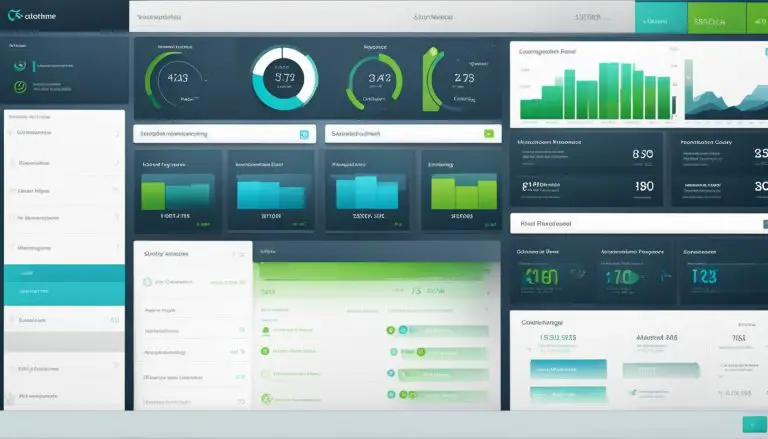Unveiling the Facts: What is Lua?
Lua is a high-level programming language that has gained popularity in various fields, including game development and embedded systems. It is known for its simplicity, flexibility, and powerful features. Lua has a clear and concise syntax, which makes it easy to learn and use. It is also highly extensible, allowing users to customize and enhance its functionality. Lua is widely used in game development, where it serves as a scripting language for creating game logic and AI. It is also used in embedded systems, where its small size and low resource usage make it ideal for devices with limited hardware capabilities. Lua has a comprehensive documentation and strong community support, making it a valuable tool for developers.
Key Takeaways:
- Lua is a high-level programming language with a simple and concise syntax.
- It is widely used in game development and embedded systems.
- Lua is known for its flexibility, extensibility, and powerful features.
- It has a comprehensive documentation and a strong community support system.
- Lua’s small size and low resource usage make it ideal for devices with limited hardware capabilities.
The Features of Lua
Lua offers a range of features that make it a versatile programming language. It has a simple and elegant syntax, which allows for easy and readable code. Lua supports procedural, functional, and object-oriented programming paradigms, providing developers with flexibility in their coding approach. It also includes powerful data structures, such as tables and coroutines, that enable efficient manipulation and processing of data. Lua is dynamically typed, meaning that variable types are determined at runtime. This allows for increased flexibility but requires careful attention to type handling. Lua also has an extensive documentation, providing comprehensive information on its syntax and usage.
One notable feature of Lua is its simplicity and elegance in syntax. The language is designed to be straightforward, making it easy to learn and understand. The code written in Lua tends to be concise and readable, resulting in efficient and maintainable programs. This simplicity also extends to Lua’s type system, which is dynamic and allows for flexible variable typing. However, it is important for developers to be mindful of type handling to ensure proper program execution.
Another feature that sets Lua apart is its support for multiple programming paradigms. Developers can choose to write Lua code in a procedural, functional, or object-oriented style, depending on their specific needs and preferences. This flexibility allows for greater creativity and adaptability in solving programming challenges.
| Lua Features | Description |
|---|---|
| Simple and elegant syntax | Allows for easy and readable code |
| Support for procedural, functional, and object-oriented programming | Gives flexibility in coding approach |
| Powerful data structures | Enables efficient manipulation and processing of data |
| Dynamic typing | Variable types determined at runtime |
| Comprehensive documentation | Provides detailed information on syntax and usage |
Lua in Game Development
Lua plays a significant role in the game development industry, serving as a versatile scripting language for implementing game logic and behavior. Its simplicity and flexibility make it an attractive choice for game developers, enabling them to iterate quickly and prototype ideas effectively.
One of the key advantages of Lua in game development is its ability to be easily integrated into game engines. Lua provides a high level of abstraction, simplifying complex tasks and allowing developers to focus on the game’s mechanics, artificial intelligence (AI), and user interfaces. It offers a powerful scripting environment that enables rapid development and iteration.
Many popular games, including World of Warcraft and Angry Birds, have embraced Lua scripting for their development process. This allows for the creation of mods and extends the functionality of existing games, promoting community participation and enhancing the overall gaming experience.
Examples of Lua in Game Development:
| Game | Role of Lua |
|---|---|
| World of Warcraft | Lua is used to implement game mechanics and UI customization. |
| Angry Birds | Lua is used for level scripting and game logic implementation. |
| Garry’s Mod | Lua is used for extending and customizing gameplay through mods. |
These examples highlight the diverse applications of Lua in game development, showcasing its versatility and effectiveness in creating engaging and immersive gaming experiences.
Lua in Embedded Systems
Embedded systems are becoming increasingly prevalent in various industries, and Lua has emerged as a popular programming language for such applications. Lua’s lightweight nature and low resource usage make it an ideal choice for IoT devices and other embedded systems with limited hardware capabilities. Its efficient memory management ensures optimal performance, even in resource-constrained environments.
Lua’s scripting capabilities play a crucial role in the customization and configuration of embedded systems. With Lua, developers can easily create scripts to control device behavior, handle sensor data, and enable communication between different components. This flexibility allows for quick deployment and updates, making Lua a valuable tool for IoT device manufacturers.
Beyond IoT devices, Lua has found applications in various embedded systems, including smart home devices, industrial control systems, and wearable technology. Its versatility and adaptability to different domains make it a go-to choice for developers working on embedded systems projects.
Table: Lua vs. Other Programming Languages for Embedded Systems
| Aspect | Lua | C | Python |
|---|---|---|---|
| Memory Usage | Low | Low | High |
| Resource Usage | Low | Low | High |
| Development Time | Short | Medium | Long |
| Flexibility | High | Medium | High |
As shown in the table above, Lua outshines other programming languages, such as C and Python, when it comes to embedded systems development. Its low memory and resource usage contribute to efficient performance, while its high flexibility allows for quick customization and adaptation. Additionally, Lua’s shorter development time makes it a favorable choice for time-sensitive projects in the embedded systems domain.
Lua Documentation and Resources
When it comes to learning Lua, having access to comprehensive documentation and resources is essential for developers of all skill levels. Thankfully, Lua provides a wealth of information and support through its official website, lua.org.
The official Lua website serves as a valuable resource for developers, offering a wide range of tutorials, examples, and a reference manual. Whether you’re a beginner looking to get started with Lua or an experienced programmer seeking specific guidance, the documentation provided by Lua is detailed and extensive.
In addition to the official Lua website, the Lua community is active and supportive, providing forums and online communities where developers can ask questions, share resources, and collaborate. These community-driven platforms are excellent sources of information and offer the opportunity to connect with other Lua enthusiasts and experts.
For developers who prefer a more structured learning approach, there are also numerous online tutorials, books, and video courses available that cover various aspects of Lua programming. These resources provide step-by-step guidance, practical examples, and insights from experienced Lua developers, helping you become proficient in Lua programming.
Table: Lua Resources
| Resource | Description |
|---|---|
| Official Lua Website | The official Lua website offers tutorials, examples, and a reference manual. |
| Lua Community Forums | Online forums where developers can ask questions, share resources, and collaborate. |
| Online Tutorials | Various online tutorials covering different aspects of Lua programming. |
| Books | Books that provide in-depth knowledge and practical examples of Lua programming. |
| Video Courses | Online video courses that offer step-by-step instruction and insights from experienced Lua developers. |
In conclusion, Lua provides a wealth of documentation and resources for developers. Whether you prefer to learn through official documentation, community forums, online tutorials, books, or video courses, you can find the support and guidance you need to master Lua programming. Take advantage of these resources to enhance your skills and unlock the full potential of Lua.
Advantages of Lua
Lua offers several advantages that make it a preferred choice among developers. Its simplicity and clear syntax make it easy to learn and use, reducing the learning curve for beginners. The flexibility of Lua allows developers to apply multiple programming paradigms, including procedural, functional, and object-oriented programming. This versatility provides developers with the freedom to choose the most suitable approach for their projects.
Another significant advantage of Lua is its low resource usage and efficient memory management. This makes it a great fit for devices with limited hardware capabilities, such as embedded systems and IoT devices. Lua’s lightweight nature enables speedy execution and optimal performance, ensuring smooth operations even when resources are scarce.
Lua also benefits from a strong community support system and comprehensive documentation. The Lua community actively contributes to the language’s development and provides valuable assistance to developers through forums, mailing lists, and other online platforms. Additionally, Lua’s extensive documentation offers detailed information on syntax, features, and usage, making it easier for developers to make the most of the language’s capabilities.
In summary, Lua’s advantages lie in its simplicity, flexibility, low resource usage, and strong community support. These factors contribute to its popularity among developers and make it a valuable tool for a wide range of applications in various industries.
Common Uses of Lua
Lua is a versatile programming language that finds applications in various domains. Its simplicity, flexibility, and powerful features make it adaptable to different industries and use cases. Here are some common uses of Lua:
1. Game Development
Lua is widely used in the game development industry, particularly as a scripting language. It allows developers to implement game logic, behavior, and AI. Lua’s simplicity and flexibility make it an attractive choice for game development, enabling quick iteration and prototyping of ideas. Game engines often integrate Lua, providing a high level of abstraction and simplifying complex tasks. Popular games like World of Warcraft and Angry Birds have leveraged Lua scripting for their development process.
2. Embedded Systems
Lua is also popular in the field of embedded systems, especially for Internet of Things (IoT) devices. Its small size, low resource usage, and efficient memory management make it ideal for devices with limited hardware capabilities. Lua’s scripting capabilities allow easy customization and configuration of IoT devices, facilitating quick deployment and updates. Its lightweight nature and low overhead contribute to its popularity in embedded systems, where efficiency and performance are crucial. Lua has been used in smart home devices, industrial control systems, and wearable technology.
3. Web Development
Lua is not limited to game development and embedded systems; it has also found applications in web development. Lua can be embedded into web servers to enhance performance and scalability. It can also be used as a scripting language for dynamic webpage generation. Lua’s simplicity, flexibility, and efficient resource usage make it a suitable choice for web development projects, particularly those requiring high performance and customization.
4. Automation and Scripting
Lua’s lightweight nature and ease of use make it an excellent choice for automation and scripting tasks. Lua scripts can automate repetitive tasks, perform system administration tasks, and enhance productivity. Its simplicity and flexibility allow developers to create powerful scripts for automating various processes, saving time and effort.
5. Scientific Research
Lua’s simplicity and efficiency make it a popular choice in scientific research applications. Lua can be used as a scripting language in scientific simulations, data analysis, and visualization. Its flexibility enables scientists and researchers to create custom tools and algorithms tailored to their specific needs.
These are just a few examples of how Lua can be used across different industries and applications. Its versatility, combined with its simplicity, flexibility, and efficient resource usage, makes Lua a valuable programming language for developers in various fields.
Lua Examples
Here are a few examples of Lua code snippets to showcase its syntax and capabilities:
Example 1:
function calculate_sum(a, b)
return a + b
end
This example demonstrates a simple Lua function that calculates the sum of two numbers. The function takes two parameters, “a” and “b”, and returns their sum. In Lua, functions are defined using the “function” keyword followed by the function name and a pair of parentheses. The body of the function is enclosed in a block that is indented. This example highlights Lua’s clear and concise syntax.
Example 2:
local fruits = {“apple”, “banana”, “orange”}
for i, fruit in ipairs(fruits) do
print(“I love ” .. fruit)
end
In this example, an array called “fruits” is defined, containing three elements: “apple”, “banana”, and “orange. The “for” loop is used to iterate over each element of the array. The “ipairs” function is used to retrieve the index and value of each element. Within the loop, the Lua “print” function is used to output a message for each fruit. This example demonstrates Lua’s support for data manipulation and looping constructs.
Example 3:
local function factorial(n)
if n == 0 then
return 1
else
return n * factorial(n-1)
end
end
This example showcases a Lua function called “factorial” that calculates the factorial of a given number. The function uses recursion to calculate the factorial by multiplying the number with the factorial of its predecessor. This example demonstrates Lua’s support for recursive functions and showcases its flexibility in solving complex mathematical problems.
These examples provide a glimpse into the syntax and capabilities of Lua. Whether it’s simple arithmetic calculations, data manipulation, or solving complex problems, Lua offers a versatile and powerful toolset for developers to create a wide range of applications.
Future Developments and Evolving Lua Ecosystem
As Lua continues to gain popularity and expand its use in various industries, its future developments and the evolution of its ecosystem are of great interest to developers and enthusiasts. The Lua community remains actively engaged in pushing the boundaries of the language, proposing enhancements, and addressing any issues that may arise. The Lua mailing list and other community-driven platforms serve as valuable hubs for collaboration and knowledge exchange.
The Lua ecosystem is also constantly evolving with the development of new libraries, frameworks, and tools that further enhance Lua’s capabilities. These additions provide developers with a wide range of options and functionalities to explore, making Lua even more versatile and adaptable to different use cases. The continuous growth of the Lua ecosystem not only empowers developers but also ensures that Lua remains a relevant and powerful programming language in the future.
Looking ahead, Lua’s future developments may take shape in several areas. One potential direction is the integration of Lua with emerging technologies like machine learning and artificial intelligence. As these fields continue to advance, Lua’s simplicity and flexibility could make it an attractive choice for implementing AI algorithms and models. Additionally, Lua may see improvements in performance optimization and memory management, further solidifying its position as a language of choice for resource-constrained devices and systems.
In conclusion, Lua’s future looks promising as it continues to evolve and adapt to the changing needs of the technological landscape. With an active community and a growing ecosystem, Lua is well-positioned to remain a relevant and powerful programming language for years to come.

Conclusion
In conclusion, Lua is a powerful and versatile programming language that offers simplicity, flexibility, and powerful features. It finds applications in various domains, including game development, embedded systems, web development, and more. Lua’s clear syntax, extensive documentation, and strong community support make it easy to learn and use.
Its low resource usage and efficient memory management make it an ideal choice for devices with limited hardware capabilities. Whether you are a beginner or an experienced developer, Lua provides a valuable tool for developing applications and exploring new possibilities.
With its continued evolution, Lua’s ecosystem is expanding with new libraries, frameworks, and tools that enhance its capabilities. The Lua community actively contributes to the language’s development, pushing the boundaries of what Lua can do. As technology advances, Lua will continue to adapt, making it a language to watch in the future.
FAQ
What is Lua?
Lua is a high-level programming language known for its simplicity, flexibility, and powerful features.
What are the features of Lua?
Lua has a simple and elegant syntax, supports procedural, functional, and object-oriented programming paradigms, and includes powerful data structures.
How is Lua used in game development?
Lua serves as a scripting language for implementing game logic and behavior, allowing for rapid development of game mechanics, AI, and user interfaces.
How is Lua used in embedded systems?
Lua is commonly used in IoT devices and other embedded systems due to its small size, low resource usage, and efficient memory management.
Where can I find Lua documentation and resources?
Lua has comprehensive documentation available on its official website, lua.org, along with online tutorials, books, and video courses.
What are the advantages of using Lua?
Lua’s simplicity, flexibility, low resource usage, and strong community support are some of its key advantages.
In what domains is Lua commonly used?
Lua finds applications in game development, embedded systems, web development, automation, scientific research, and more.
Can you provide some examples of Lua code?
Sure! Here are a few examples of Lua code snippets to showcase its syntax and capabilities:
How is Lua evolving and adapting to changing technology trends?
The Lua community actively contributes to the development of the language, proposing enhancements and addressing issues.
- About the Author
- Latest Posts
Mark is a senior content editor at Text-Center.com and has more than 20 years of experience with linux and windows operating systems. He also writes for Biteno.com






